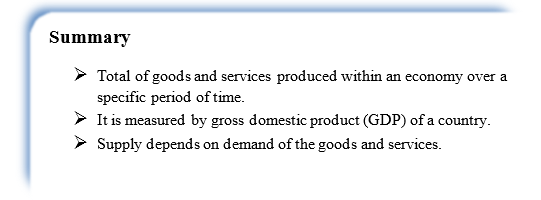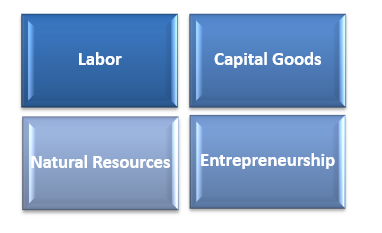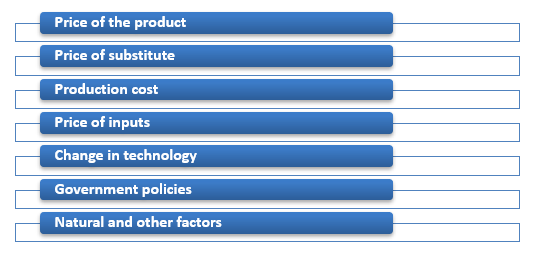What is Aggregate supply?
Aggregate supply refers to the sum (total) of all goods and services produced within an economy during a specific period of time. It is the addition of all the good and services that suppliers want to sell at a specific price level in an economy. It is also called domestic final supply.

Source: Copyright © 2021 Kalkine Media Pty Ltd
Understanding of Aggregate supply
The concept of aggregate supply comes from the term supply. Supply is an economic term that defines the quantity of a goods or service that firms provide to buyers or customer at a specific price over a period of time.
Aggregate supply is an economic concept that represents the total amount of goods and services offered by a supplier to its customer. The concept of supply is closely related to the concept of demand: supply of any good and service likely to increase if the price of the good and service goes up because companies expand their production only to match the increasing demand.
Frequently Asked Questions
What are the factors of Aggregate Supply?
There are four factors of production which helps a supplier to be in long-run. These factors are as follow:

Source: Copyright © 2021 Kalkine Media Pty Ltd
Labour: To meet the demand of market, firms have to expand their production accordingly. To offer the enough supply of goods, firms need more labour or human resource.
Capital Goods: To produce good, firms need capital goods for purchasing technology, such as machinery and equipment. Capital goods increase the efficiency of production.
Natural Resources: Natural resources refer to the resources which are gifted by nature, like land, oil, air, water, climate etc. Labor uses this raw material to produce goods in order to meet supply.
Entrepreneurship: An entrepreneur is an individual who establishes new business with the motive of profit. They are business owners who have ability to produce and innovate.
How Aggregate supply works in short or long run?
In short-run, aggregate supply depends on price of goods in market. As demand rises, buyers are ready to pay high price. Firms will increase supply by increasing the use of currently available resources in the production to gain profits from higher prices. In short run, amount of capital is limited, and a company cannot increase his efficiency by purchasing new machinery or stating a new factory. Instead, a company utilises their inputs of factor of production until they reach their optimum capacity.
In the long-run, price level has no impact on aggregate supply. If the price and demand of goods go on increasing, companies can improve their productivity and efficiency in order to increase supply. They have enough time to enhance the skill and educate the workers and can do technological changes if factories required.
For example, ABC manufacturing company produces 2,00,000 pieces of shirt per quarter at a total expense of £1.5 million. But in current quarter there is rise in demand by 2%. ABC tries to produce more in order to meet the demand but would not be able to because the producing capacity of machinery is not according to the need. And the company cannot build a new plant or machinery in a short period of time. This shortage of capital represents a less aggregate supply.
What is the determinate of changes in aggregate supply?
A movement in aggregate supply curve is due to various factors. However, some of these factors have a positive impact in aggregate supply while others may result decrease in aggregate supply. It includes:

Source: Copyright © 2021 Kalkine Media Pty Ltd
- Price of the product: According to the law of supply, there is a positive relationship between price and supply. If the price of a particular product will rise, in result the aggregate supply of that product will increase.
- Price of substitute products: Price of substitute goods and services directly effects aggregate supply of their substitutes in market. For example, Colgate and Close Up are substitutes. There is an inverse relation with the supply of related goods and services.
- Production cost: Change in price of factors of products directly lead the change in the aggregate supply. If the price of factors of production goes down it will result increase in aggregate supply and if the price of these factors goes up, it directly decrease the aggregate supply.
- Price of inputs: If the price of raw material is changed either goes up and down it affects the aggregate supply. There is inverse relation between price of inputs and the aggregate supply.
- Change in technology: Technology is changing by time, new innovations and machineries are introduced in market every day. Change in technology effect the efficiency of the production which leads change in the aggregate demand.
- Government policies: Unstable government may lead the changes in producer taxes, subsidies which affects the capital power of an individual. Change in capital power of an individual leads change in aggregate supply.
- Natural and other factors: Natural calamities are unpredictable and uncontrollable such as earthquake, flood etc. It is one of the reasons of change in the aggregate supply. (SOURCE: https://capital.com/supply-definition)
How aggregate supply and aggregate demand are correlated
The law of supply and demand leads what amount of supply needed in market. According to the law of supply, supply increases when the price increases which shows the positive relation between supply and the price. Therefore, if the price goes down supply goes down too. However, businesses may:
- a) Lower down supply,
- b) Reducing the operating costs to in order to maintain profit margins.
On the other side, as per the law of demand, demand decreases as the price increases which shows the inverse relation between price and demand. The right price is decided on the basis of interaction of demand and supply curve, will get equilibrium price at the point of intersection of these curve. It is the situation when the amount supply equals the amount demand. Aggregate demand is the addition of the production of all the final goods and services within an economy.
Prices or production change or adjust to the point supply equal to demand. Price has different effect on the demand and supply of goods and services. Hence, supply depended on demand, but demand won't depend on supply.
 Please wait processing your request...
Please wait processing your request...